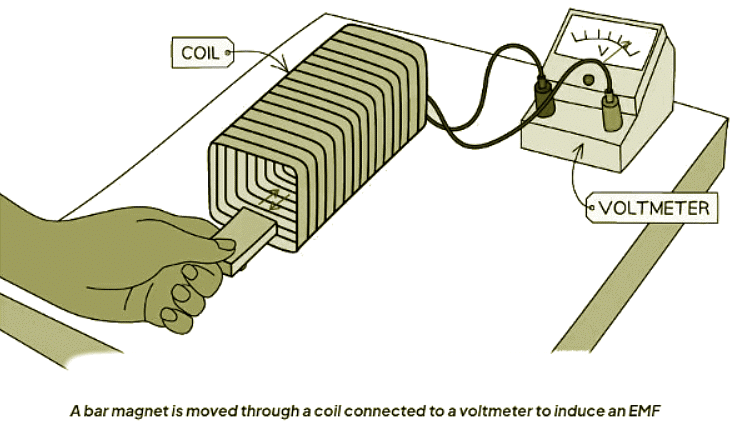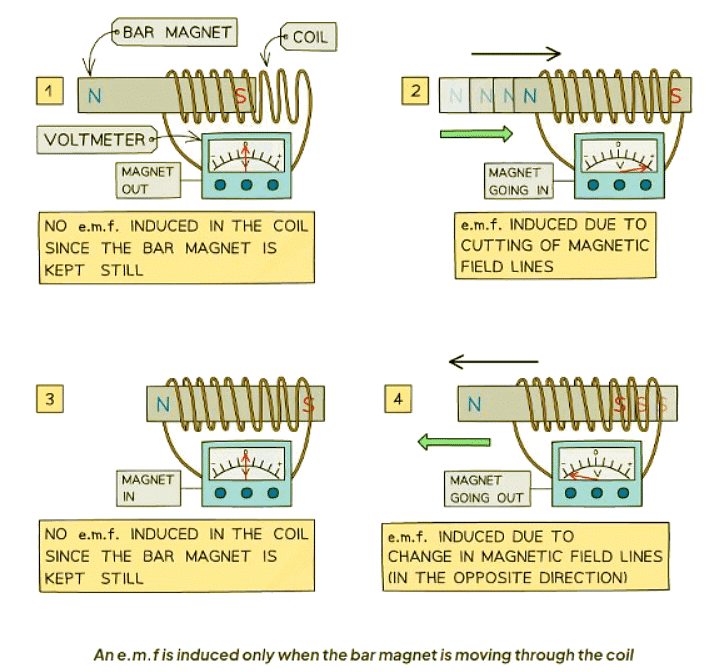Class 10 Exam > Class 10 Notes > Physics for GCSE/IGCSE > Demonstrating Induction
Demonstrating Induction | Physics for GCSE/IGCSE - Class 10 PDF Download
Demonstrating Induction
- An electromotive force (EMF) can be induced in a conductor, like a wire, when it moves through a magnetic field.
- The direction of a magnetic field passing through a coil changes, resulting in the induction of an EMF.
- When a conductor, such as a wire, moves through a magnetic field.
- When the direction of the magnetic field passing through a coil is altered.
- Demonstrations of electromagnetic induction are prevalent in various applications:
- Electrical generators: These devices convert mechanical energy into electrical energy through electromagnetic induction.
- Transformers: They play a crucial role in transmitting electrical power efficiently.
- This phenomenon is commonly illustrated using a magnet and a coil setup.
Experiment 1: Moving a magnet through a coil
When a coil is linked to a sensitive voltmeter, the insertion and removal of a bar magnet within the coil can generate an electromotive force (EMF).

The expected results are:
- When a bar magnet is stationary near a coil, the voltmeter reads zero.
- There is no induced electromotive force (EMF) when the magnet is held still inside or outside the coil since there is no cutting of magnetic field lines.
- As the bar magnet starts moving inside the coil, the voltmeter shows a reading.
- When the magnet moves, its magnetic field lines intersect with the coil, inducing an EMF momentarily detected by the voltmeter.
- Removing the magnet from the coil induces an EMF in the opposite direction due to Lenz's law, signifying the change in current direction.
- The voltmeter briefly displays a reading with the opposite sign during this transition.
- Increasing the magnet's speed results in a higher magnitude of induced EMF.
- The induced current and EMF in the conductor resist the change causing it, following Lenz's law principles.

- Factors that will enhance the induced electromotive force (EMF) include:
- Increasing the speed at which the magnet moves through the coil
- Incorporating additional turns into the coil
- Augmenting the potency of the bar magnet
Experiment 2: Moving a wire through a magnet
- When a lengthy wire is linked to a voltmeter and shifted between two magnets, it triggers an electromotive force (EMF).
- This setup enables the examination of the magnetic field pattern within the wire.
- (Note: Initially, there is no initial flow of current through the wire.)

- When a wire is stationary inside or outside magnets, there is no induced electromotive force (EMF) because the rate of change of flux is zero.
- When a wire moves through the magnetic field between magnets, an EMF is generated. This occurs as the wire 'cuts through' the magnetic field lines, causing a change in magnetic flux.
- When the wire is withdrawn from the magnets, an EMF is induced in the opposite direction. This change in direction also affects the current flow. The induced current and EMF act to oppose the changes that produce them.
- Factors that can increase the induced EMF include:
- Increasing the length of the wire
- Moving the wire between the magnets more quickly
- Increasing the strength of the magnets
Question for Demonstrating InductionTry yourself: What is the result when a bar magnet is held stationary near a coil?View Solution
Factors Affecting Electromagnetic Induction
- The induced EMF's magnitude hinges on the velocity of movement for the wire, coil, or magnet. As this speed escalates, more magnetic field lines are intersected per unit time, intensifying the induced potential difference.
- The quantity of turns on the wire coils directly impacts the induced potential difference. With more turns, there are more opportunities for magnetic field lines to be traversed, culminating in a higher total induced potential difference.
- Enlarging the size of the coils elevates the potential difference induced. This enlargement effectively increases the area of wire cutting through the magnetic field lines, thereby augmenting the overall induced potential difference.
- The strength of the magnetic field influences the induced potential difference. As this strength amplifies, so does the potential difference induced, as more flux lines are intersected by the moving conductor.
- The orientation of the magnet's poles dictates the direction of the induced potential difference. Altering the direction in which the wire, coil, or magnet is moved effectively changes the direction of the induced EMF, in accordance with Faraday's law of electromagnetic induction.
The document Demonstrating Induction | Physics for GCSE/IGCSE - Class 10 is a part of the Class 10 Course Physics for GCSE/IGCSE.
All you need of Class 10 at this link: Class 10
|
126 videos|194 docs|35 tests
|
FAQs on Demonstrating Induction - Physics for GCSE/IGCSE - Class 10
| 1. What is electromagnetic induction? |  |
Ans. Electromagnetic induction is the process of generating an electromotive force (emf) or voltage in a conductor by exposing it to a changing magnetic field.
| 2. How does electromagnetic induction work? |  |
Ans. When a conductor is exposed to a changing magnetic field, the magnetic field induces an electric current to flow in the conductor, creating an electromotive force.
| 3. What are the factors that affect electromagnetic induction? |  |
Ans. The factors that affect electromagnetic induction include the strength of the magnetic field, the speed at which the magnetic field changes, the angle at which the conductor cuts through the magnetic field, and the length of the conductor.
| 4. Can electromagnetic induction be used to generate electricity? |  |
Ans. Yes, electromagnetic induction is commonly used in devices such as generators and transformers to generate electricity by converting mechanical energy into electrical energy.
| 5. How is electromagnetic induction demonstrated in practical scenarios? |  |
Ans. Electromagnetic induction can be demonstrated through experiments such as moving a magnet through a coil of wire to generate an electric current, or by using a transformer to step up or step down voltage levels.
Related Searches















